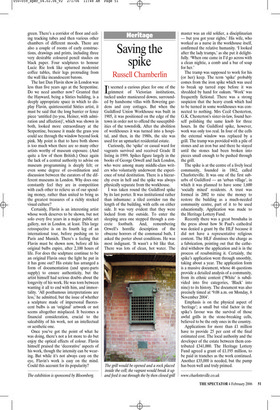Saving the spike
Russell Chamberlin
It seemed a curious place for one of the grimmest of Victorian institutions, tucked under manicured downs, surrounded by handsome villas with flowering gardens and cosy cottages. But when the Guildford Union Workhouse was built in 1905, it was positioned on the edge of the town in order not to offend the susceptibilities of the townsfolk. After the abolition of workhouses it was turned into a hospital, and then, in the 1980s, the site was used for an upmarket residential estate.
Curiously, the ‘spike’ or casual ward for vagrants survived and received Grade II listing in 1999. Spikes figure largely in the books of George Orwell and Jack London, who were among many middle-class writers who voluntarily underwent the experience of total destitution. There is a hierarchy even in hell and the spike was always physically separate from the workhouse.
I was taken round the Guildford spike by its last porter. It was institutional rather than inhumane: a tiled corridor ran the length of the building, with cells on either side. It was very evident that they were locked from the outside. To enter the sleeping area one stepped through a concrete footbath. And, remembering Orwell’s horrific description of the obscene horrors of the communal bath, I asked the porter about conditions. He was most indignant. ‘It wasn’t a bit like that. There was lots of clean, hot water. The master was an old soldier, a disciplinarian — but you got your rights.’ His wife, who worked as a nurse in the workhouse itself, confirmed the relative humanity. ‘I looked after the lady tramps,’ as she put it delightfully. ‘When one came in I’d go across with a clean nightie, a comb and a bar of soap for her.’ The tramp was supposed to work for his (or her) keep. The term ‘spike’ probably comes from the iron spike which was used to break up tarred rope before it was shredded by hand for oakum. ‘Work’ was frequently fictional. There was a strong suspicion that the heavy crank which had to be turned in some workhouses was connected to nothing. Mrs Cecil Chesterton, G.K. Chesterton’s sister-in-law, found herself polishing the same knob for three hours. In the Guildford spike, however, work was only too real. In four of the cells the external window was replaced by a grill. The tramp was provided with a pile of stones and an iron bar and there he stayed until the stones had been broken into pieces small enough to be pushed through the grill.
The spike is at the centre of a lively local community, founded in 1862, called Charlotteville. It was one of the first suburbs of Guildford — an ‘urban village’, in which it was planned to have some 1,600 ‘socially mixed’ residents. A trust was formed in 2002 to raise the money to restore the building as a much-needed community centre, part of it to be used educationally. Application was made to the Heritage Lottery Fund.
Recently there was a great brouhaha in the press about how St Paul’s cathedral was denied a grant by the HLF because it did not have a representative religious content. The HLF dismisses the charge as a fabrication, pointing out that the cathedral withdrew the application and is in the process of resubmitting it. Certainly, the spike’s application went through smoothly, taking about a year. The application form is a massive document, whose 46 questions provide a detailed analysis of a community, from its ethnic content (‘White’ is subdivided into five categories, ‘Black’ into nine) to its history. The document was also precisely timed at ‘9.08 a.m. on Monday, 8 November 2004’.
Emphasis is on the physical aspect of ‘heritage’; a small but vital factor in the spike’s favour was the survival of those awful grills in the stone-breaking cells, believed to be the only ones in the country.
Applications for more than £1 million have to provide 25 per cent of the final estimated cost. The local authority and the developer of the estate between them contributed £341,000. The Heritage Lottery Fund agreed a grant of £1.195 million, to be paid in tranches as the work continued. Another £35,000 is needed, but the pump has been well and truly primed.
www.charlotteville.co.uk





























































































































 Previous page
Previous page